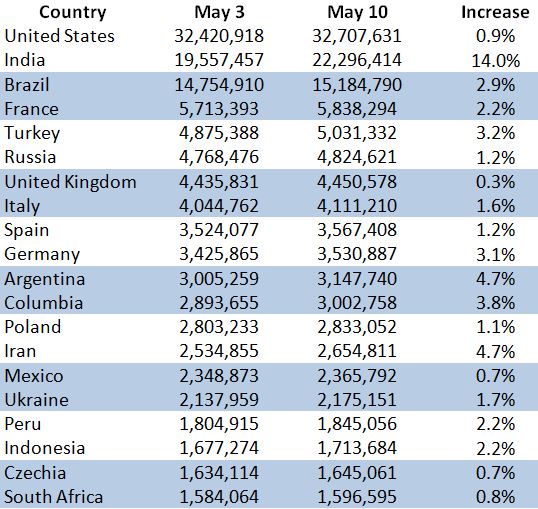On May 9, the U.S. reported only 22,073 cases of COVID-19, its lowest number of cases in 11 months. The downward slope in cases that bumped up in early April is heading downwards again as the average number of cases for the past 14 days dropped to 30 percent.
Europe is also seeing its numbers slow, although not quiet as fast as the U.S. While they are rolling our vaccines more smoothly, they are still relying on social distancing, curfews, and lockdowns to minimize cases. Over the past two weeks, new cases are down 31 percent in Germany, 40 percent in France, 29 percent in Spain, and 28 percent in Italy.
Unfortunately, the same cannot be said for the hotspots of the world. Brazil, which has seen more than 15 million cases and 422,000 deaths is seeing an uptick in cases, with 8 percent growth in new cases reported over the past 14 days. India, with more than 22 million cases and 242,000 deaths is up 23 percent in the past 14 days, with around 400,000 cases reported per day. In fact, India alone produces about half the world’s cases.
Why this Matters
Now maybe you are thinking, “That’s too bad, but I don’t plan to go there and I don’t know anyone who lives there, so I am unaffected by cases in India or Brazil. I just want to go out to dinner without my mask, get my kids back in school and be able to go on vacation this summer.”
Here’s why a high caseload in India (or anywhere else) matters: think of every case as a petri dish. In each victim, the virus may pick up some DNA from another virus in that person, and to potentially evolve. It may evolve into something less harmful, but it may also evolve into something more dangerous or more contagious. As that mutation spreads to new hosts, it may spread faster than the original virus.
The more cases there are, the more chances the virus may mutate. That increases the odds that a more deadly, more contagious virus that can evade the vaccine is going to occur. If we don’t get a handle on COVID-19, I think it’s likely that we could go through this shutdown process every few years, assuming that people will allow it. That would be just terrible for our country and for the world. We barely survived 2020. No one wants a repeat of that in 2023 and again in 2028.
In short, it’s not over until it’s over, and it may never be over. We could live with COVID like we live with the flu, only with more dangerous or more frequent flare-ups.
Global Numbers
Here’s a look at how the 20 countries with the largest total cases have performed over the past week:

This week, there were no changes in order. As expected, Columbia surpassed the 3 million mark, but only by a couple thousand. The biggest change is at the top of the list: The U.S. dropped to less than 1 percent growth over the course of a week for the first time since we have been keeping records.
Eighteen of the 20 countries on the list saw their rate drop, with UK staying the same a 0.3 and South Africa climbing from 0.5 to 0.8. While India’s rate dropped, the number of new cases actually climbed.







